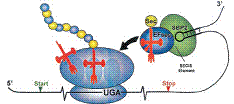Biochemistry, Department of

Vadim Gladyshev Publications
Document Type
Article
Date of this Version
April 2005
Abstract
Selenocysteine (Sec) is co-translationally inserted into selenoproteins in response to codon UGA with the help of the selenocysteine insertion sequence (SECIS) element.The number of selenoproteinsinanimals varies, with humans having 25 and mice having 24 selenoproteins. To date, however, only one selenoprotein, thioredoxin reductase, has been detected in Caenorhabditis elegans, and this enzyme contains only one Sec. Here, we characterize the selenoproteomes of C.elegans and Caenorhabditis briggsae with three independent algorithms,one searching for pairs of homologous nematode SECIS elements, another searching for Cys- or Sec-containing homologs of potential nematode selenoprotein genes and the third identifying Sec-containing homologs of annotated nematode proteins. These methods suggest that thioredoxin reductase is the only Sec-containing protein in the C.elegans and C.briggsae genomes. In contrast, we identified additional selenoproteins in other nematodes. Assuming that Sec insertion mechanisms are conserved between nematodes and other eukaryotes, the data suggest that nematode selenoproteomes were reduced during evolution, and that in an extreme reduction case Sec insertion systems probably decode only a single UGA codon in C.elegans andC.briggsae genomes. In addition, all detected genes had a rare form of SECIS element containing a guanosinein place of a conserved adenosine present in most other SECIS structures, suggesting that in organisms with small selenoproteomes SECIS elements may change rapidly.


Comments
Published by Nucleic Acids Research, 2005, Vol. 33, No. 7 2227–2238. © The Author 2005. Published by Oxford University Press. Permission to use.